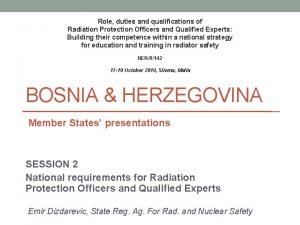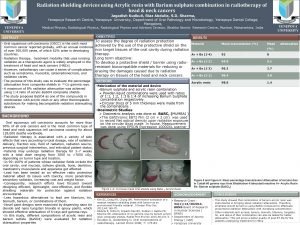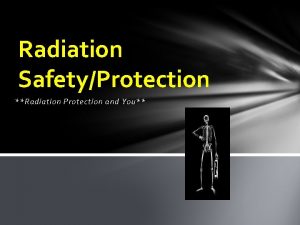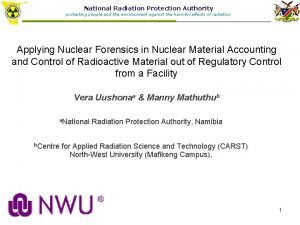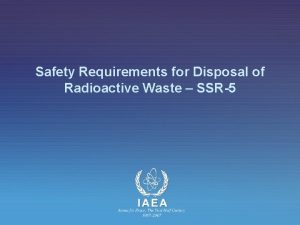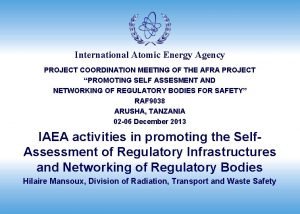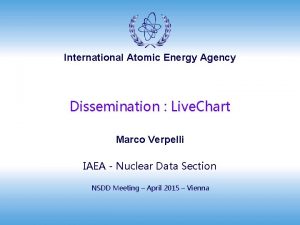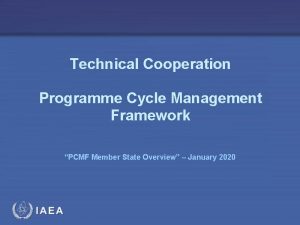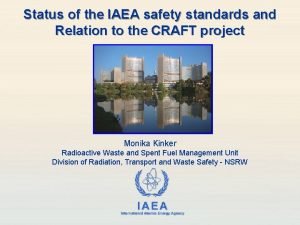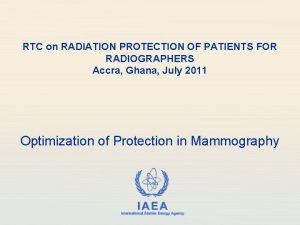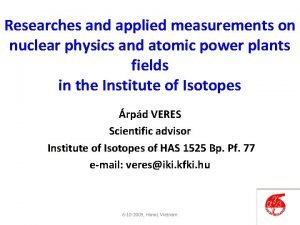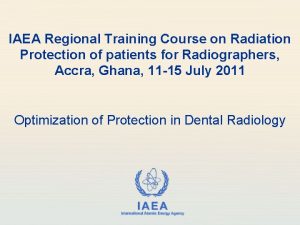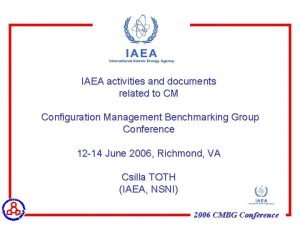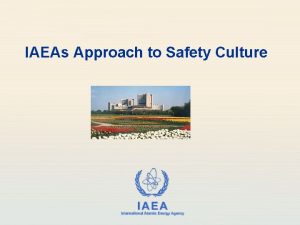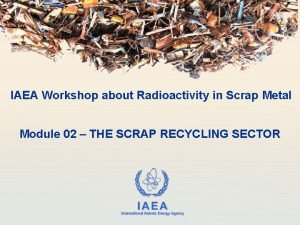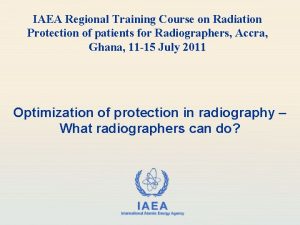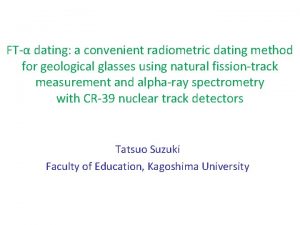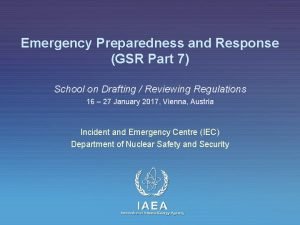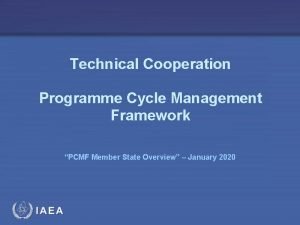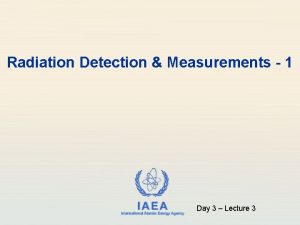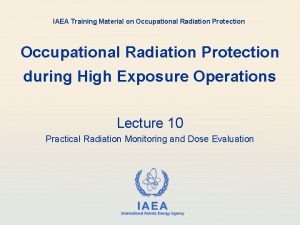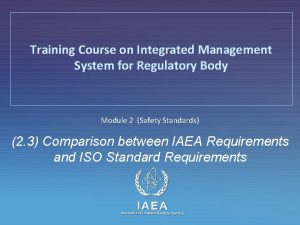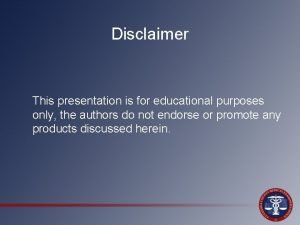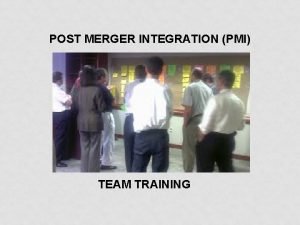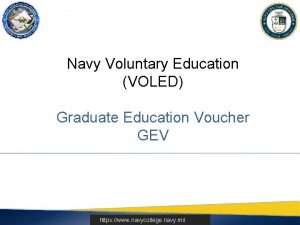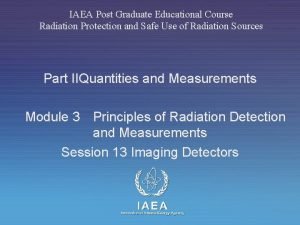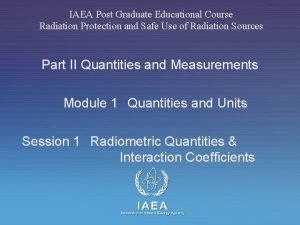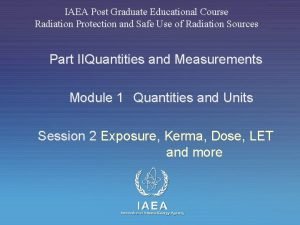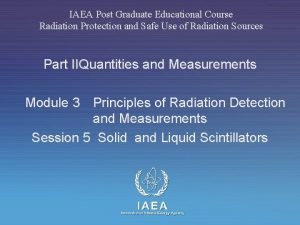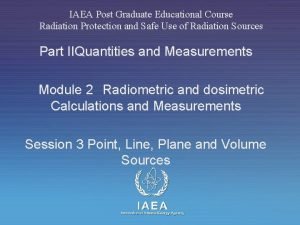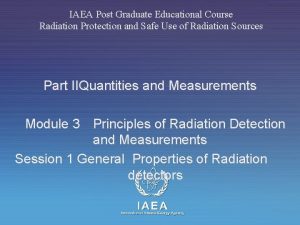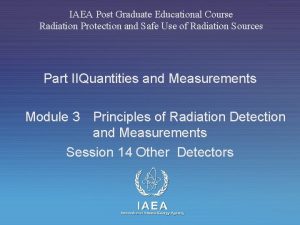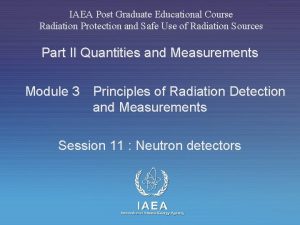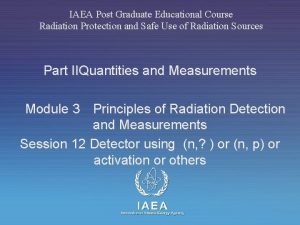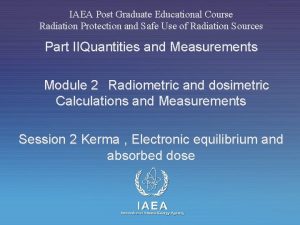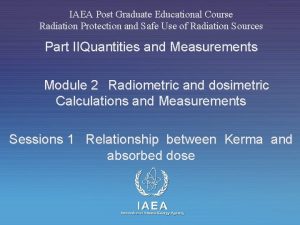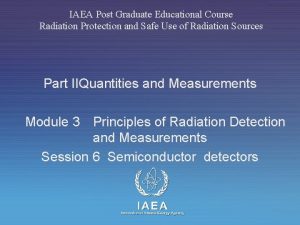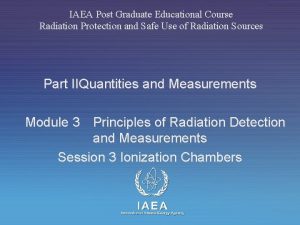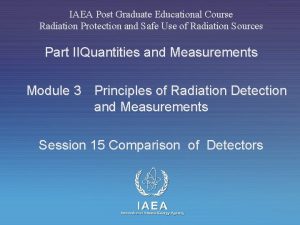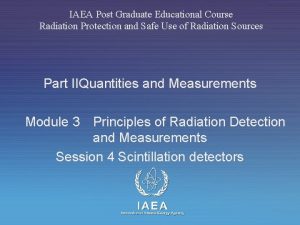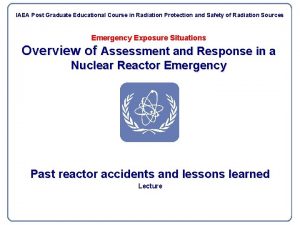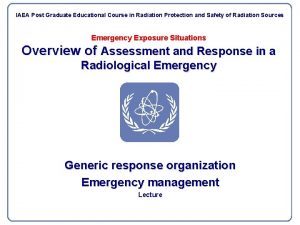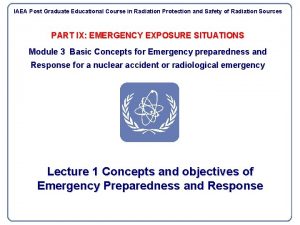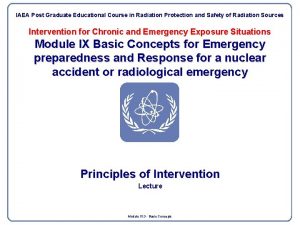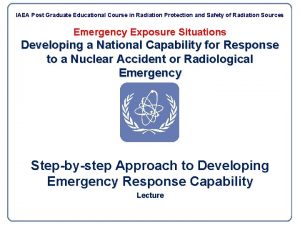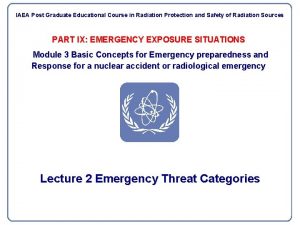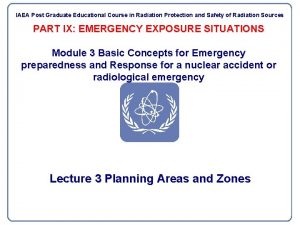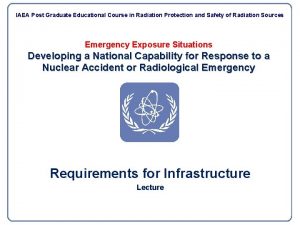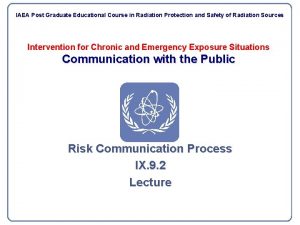IAEA Post Graduate Educational Course in Radiation Protection








































- Slides: 40

IAEA Post Graduate Educational Course in Radiation Protection and Safety of Radiation Sources Intervention for Chronic and Emergency Exposure Situations Basic Concepts of Emergency Response Protective Actions Lecture Module X. 2 - Basic Concepts of Emergency Response

Introduction l In the event of an accident, protective actions may need to be taken to control the radiation exposures of members of the public l The purpose of this lesson is to present background and guidance on major protective actions Module X. 2 - Basic Concepts of Emergency Response 2

Content l l Exposure pathways Protection strategy Protective actions n Evacuation n Sheltering n Thyroid blocking n Relocation and resettlement n Agricultural countermeasures Operational Intervention Levels Module X. 2 - Basic Concepts of Emergency Response 3

Three Major Principles l The protective actions should n Prevent serious deterministic effects wherever possible n Be justified – they should do more good than harm n Be optimised – they should do the most good Module X. 2 - Basic Concepts of Emergency Response 4

Exposure Pathways and Protective Actions l Exposure of individuals may be external or internal and may be incurred by various pathways l The various routes by which individuals may be exposed will influence decisions which protective actions should be taken to prevent or reduce the exposure Module X. 2 - Basic Concepts of Emergency Response 5

Human Exposure Pathways Plume Fresh produce Cloud shine Inhalation Shine from ground contamination (ground shine) Immediate ingestion Fresh milk Skin contamination Module X. 2 - Basic Concepts of Emergency Response 6

Module X. 2 - Basic Concepts of Emergency Response 7

Preventive vs. Protective Actions l l Protective actions n taken to avoid consequences to health n based on measurements or predictions Preventive, or risk reduction actions n taken to avoid the risk of exposure n based on plant conditions n no time for detailed analysis n applies where protective actions may not be adequate or fast enough Module X. 2 - Basic Concepts of Emergency Response 8

Preventive Actions l l l Should be initiated before or shortly after a major release from core damage accident You can predict core damage before a release You can not predict the time or size of release once you have core damage Therefore must act on the status of the core Should not wait for a release before taking action Module X. 2 - Basic Concepts of Emergency Response 9

Emergency Assessment l Given large uncertainties and need for timely decisions in order for protective actions to be effective n As simple as possible, yet effective n Based on best understanding of severe accidents and international guidance n Focus on data important for decision-making n Do not be side-tracked by data that do not influence the decision-making n Considerable time is needed to implement decisions n Only use data that will be available at the time Module X. 2 - Basic Concepts of Emergency Response 10

Strategy to Reduce Public Risk l l Before or shortly after release - based on plant conditions n Evacuate or substantial shelter within 3 - 5 km n Take thyroid blocking near the plant After a release n Prompt monitoring to locate areas requiring further protective actions. n Restrict consumption of locally grown food to 300 km n Monitoring to locate where food restrictions and relocation are warranted Module X. 2 - Basic Concepts of Emergency Response 11

Example of Threat and Action Strategy l For typical core melt accident with early containment failure n Acute inhalation dose and ground shine major contributors to deaths within 2 km n Ground shine most important > 2 km n Close in-take action quickly to avert dose from plume n Monitor further, and evacuate hot spots Module X. 2 - Basic Concepts of Emergency Response 12

Protective Action Strategy Core Damage Accidents l Before or shortly after release - based on plant conditions n Evacuation or substantial sheltering within 3 - 5 km n Take thyroid blocking near the plant Module X. 2 - Basic Concepts of Emergency Response 13

Protective Action Strategy Core Damage Accidents l After a release n Prompt monitoring to locate areas requiring further protective actions. n Restrict consumption of locally grown food out to 300 km n Monitoring to locate where food restrictions and relocation is warranted l After the start of release revise protective based on environmental measurements Module X. 2 - Basic Concepts of Emergency Response 14

Basic Instructions l Following a major release from core damage accident instruct people within 300 km n Do not drink milk from grazing animals n Do not eat potentially contaminated vegetables n Do not drink rain water unless it would cause severe food shortages and until it has been monitored Module X. 2 - Basic Concepts of Emergency Response 15

Protective Actions l l l Urgent protective actions n Sheltering n Evacuation n Administration of stable iodine Longer term protective actions n Temporary relocation n Resettlement Agricultural countermeasures Module X. 2 - Basic Concepts of Emergency Response 16

Sheltering l l l Protects against external radiation from cloud and ground; some protection against inhalation Most effective when properly applied Effectiveness depends on type of dwelling Duration limited to about 2 days Must be prompt May lead to spontaneous evacuation Module X. 2 - Basic Concepts of Emergency Response 17

Types of Shelters and Effectiveness Module X. 2 - Basic Concepts of Emergency Response 18

Effectiveness of Sheltering and Evacuation in Plume Module X. 2 - Basic Concepts of Emergency Response 19

Evacuation l l l Most effective action for areas close to a facility Must be initiated prior to a release to avoid inhalation from the plume Must be timely to avoid external radiation from the ground Difficult to manage Spontaneous evacuation possible Module X. 2 - Basic Concepts of Emergency Response 20

Module X. 2 - Basic Concepts of Emergency Response 21

Thyroid Blocking l l l l KI pills Protect against inhalation and ingestion of radioiodine only Very effective if taken early, especially for children Complex distribution strategies n Difficult to distribute during emergency n Difficult to maintain if pre-distributed n Transient populations? Limited shelf life Large stock piles required Must be part of overall strategy Module X. 2 - Basic Concepts of Emergency Response 22

Effectiveness of Thyroid Blocking with Time 100 mg of Iodine - 130 mg of KI Module X. 2 - Basic Concepts of Emergency Response 23

Relocation and Resettlement l l l To keep population out of the affected areas Relocation: more than 7 days but not more than few months Resettlement: permanent Expensive Disruptive Module X. 2 - Basic Concepts of Emergency Response 24

Psychological Effects of Relocation l l l Relocation is especially dubious Has negative impact on mental well being If aimed to reduce risk for stochastic effects: n Consider only future avoidable dose n Dose already achieved cannot be reduced Involuntarily relocated people suffer most Elderly people are especially likely to suffer Module X. 2 - Basic Concepts of Emergency Response 25

Agricultural Countermeasures l Not to be considered urgent, though it should be timely n Applied directly to plants or to soil n Appropriate processing of food l Expensive Great detriment to farmers: compensation costs Alternate food supplies required Loss of confidence in food supplies l l l Module X. 2 - Basic Concepts of Emergency Response 26

Public Monitoring and Decontamination l l l Skin contamination could contribute to deterministic effects Public should be monitored Should not delay evacuation Screening or monitoring a sample is only practical method Instruct people to shower and change clothes as soon as possible Module X. 2 - Basic Concepts of Emergency Response 27

BSS GILs and GALs l l l Not directly readable on instrument Develop operational intervention levels (OIL) as part of planning OIL readable on instruments used OIL used during accident to make decisions IAEA has developed suggested default OILs Revise defaults during accident Module X. 2 - Basic Concepts of Emergency Response 28

Gamma Dose Rate Measurements in Environment l l l Most important environmental monitoring Easy to measure with simple instrument and little training Can use to decide where to: n evacuate n shelter n give thyroid blocking n relocate Module X. 2 - Basic Concepts of Emergency Response 29

Operational Intervention Levels l l After the start of release revise preventive actions based on environmental measurements n Intervention Levels can not be used directly n Not directly readable on instrument Develop Operational Intervention Levels (OIL) as part of planning n OIL readable on instruments used n Use to make and communicate prompt decisions in early phase IAEA has suggested default OILs Revise defaults during accident Module X. 2 - Basic Concepts of Emergency Response 30

Default Ground Gamma Dose Rate Oils For Evacuation An Example 50 m. Sv 168 h 0. 5 Evacuation GIL Hours in 7 days Dose reduction due to normal activity Dose reduction due to decay Module X. 2 - Basic Concepts of Emergency Response 31

Default Gamma Dose Rate OILs 1. 0 m. Sv/h ( 100 m. R/h) - Evacuate 0. 2 m. Sv/h (20 m. R/h) - Relocate 0. 1 m. Sv/h (10 m. R/h) - Thyroid blocking 1. 0 µSv/h (100µR/h) - Restrict local food 0. 1 µSv/h (10µR/h) - Typical Background Module X. 2 - Basic Concepts of Emergency Response 32

Crop and Milk OILs l Gamma dose rate OIL inadequate Use deposition concentration Used to determine areas where restrictions should be considered or relaxed l Use marker (single) isotope - faster l Based on assumptions of release mix l l Module X. 2 - Basic Concepts of Emergency Response 33

Release Mixture GAL & Units Used Deposition Rates Default Ingestion OIL Instruments Used Retention on Food Preparation Some of the assumptions in development of default ingestion OIL Module X. 2 - Basic Concepts of Emergency Response 34

Deposition Marker Isotope OILs to Restrict Food Produced in Contaminated Area l l 10 k. Bq/m 2 - I-131 food 2 k. Bq/m 2 - I-131 milk 2 k. Bq/m 2 - Cs-137 food 10 k. Bq/m 2 - Cs-137 milk Module X. 2 - Basic Concepts of Emergency Response 35

Food Concentrations OILs l l 1 Bq/kg - I-131 in food 0. 1 k. Bq/kg - I-131 in milk, water 0. 2 k. Bq/kg - Cs-137 in food 0. 3 k. Bq/kg - Cs-137 in milk, water Module X. 2 - Basic Concepts of Emergency Response 36

Use of OILs Use Default OILs Determine where OILs exceeded- Take protective action Determine Accident Specific Information Recalculate OILs Adopt revised OILs NO Major Difference? Module X. 2 - Basic Concepts of Emergency Response YES 37

Summary l l l Part of conventional emergency management Objectives of response Practical considerations n Favour evacuation close in over other actions for severe accidents n Combination of sheltering and evacuation can be effective n KI pills can enhance effectiveness of sheltering n Operational intervention levels Module X. 2 - Basic Concepts of Emergency Response 38

Summary l l Establish OILs and methods before the accident, not during ! Use IAEA support material Module X. 2 - Basic Concepts of Emergency Response 39

Where to Get More Information INTERNATIONAL ATOMIC ENERGY AGENCY Intervention Criteria in a Nuclear or Radiation Emergency Safety Series No. 109, Vienna (1994) Module X. 2 - Basic Concepts of Emergency Response 40
 Radiation protection officer qualifications
Radiation protection officer qualifications Barium sulphate board for radiation protection
Barium sulphate board for radiation protection Cardinal principles of radiation protection
Cardinal principles of radiation protection National radiation protection authority namibia
National radiation protection authority namibia Ssr-5
Ssr-5 Saris iaea
Saris iaea Livechart iaea
Livechart iaea Pcmf
Pcmf Iaea gsr part 4
Iaea gsr part 4 Rtc protection film
Rtc protection film Nuclear wastes
Nuclear wastes Iaea
Iaea Stefano monti iaea
Stefano monti iaea Iaea
Iaea Iaea
Iaea Steel scrap
Steel scrap Iaea
Iaea Iaea
Iaea Gsr part 7
Gsr part 7 Iaea pcmf
Iaea pcmf Iaea
Iaea Iaea
Iaea Gsr part 2
Gsr part 2 For school purposes only
For school purposes only Integration
Integration One brick t junction in english bond
One brick t junction in english bond Course number and title
Course number and title Course interne course externe
Course interne course externe Zeta phi beta pledging process
Zeta phi beta pledging process Gss graduate route
Gss graduate route Graduate success attributes
Graduate success attributes Binus graduate attributes
Binus graduate attributes Graduate attributes utm
Graduate attributes utm Lsu thesis and dissertation library
Lsu thesis and dissertation library Graduate college jamshedpur
Graduate college jamshedpur Aldi graduate scheme review
Aldi graduate scheme review 15-780 graduate artificial intelligence
15-780 graduate artificial intelligence Sgra upm
Sgra upm Pfizer uk graduate scheme
Pfizer uk graduate scheme Ogaps dpss
Ogaps dpss Navy gev
Navy gev
